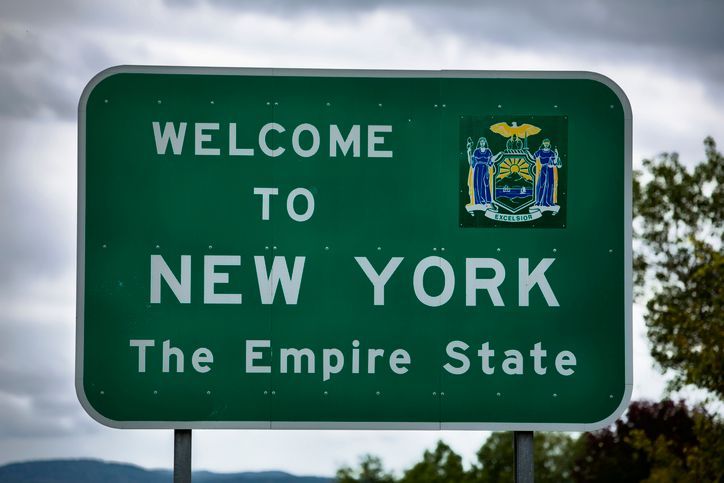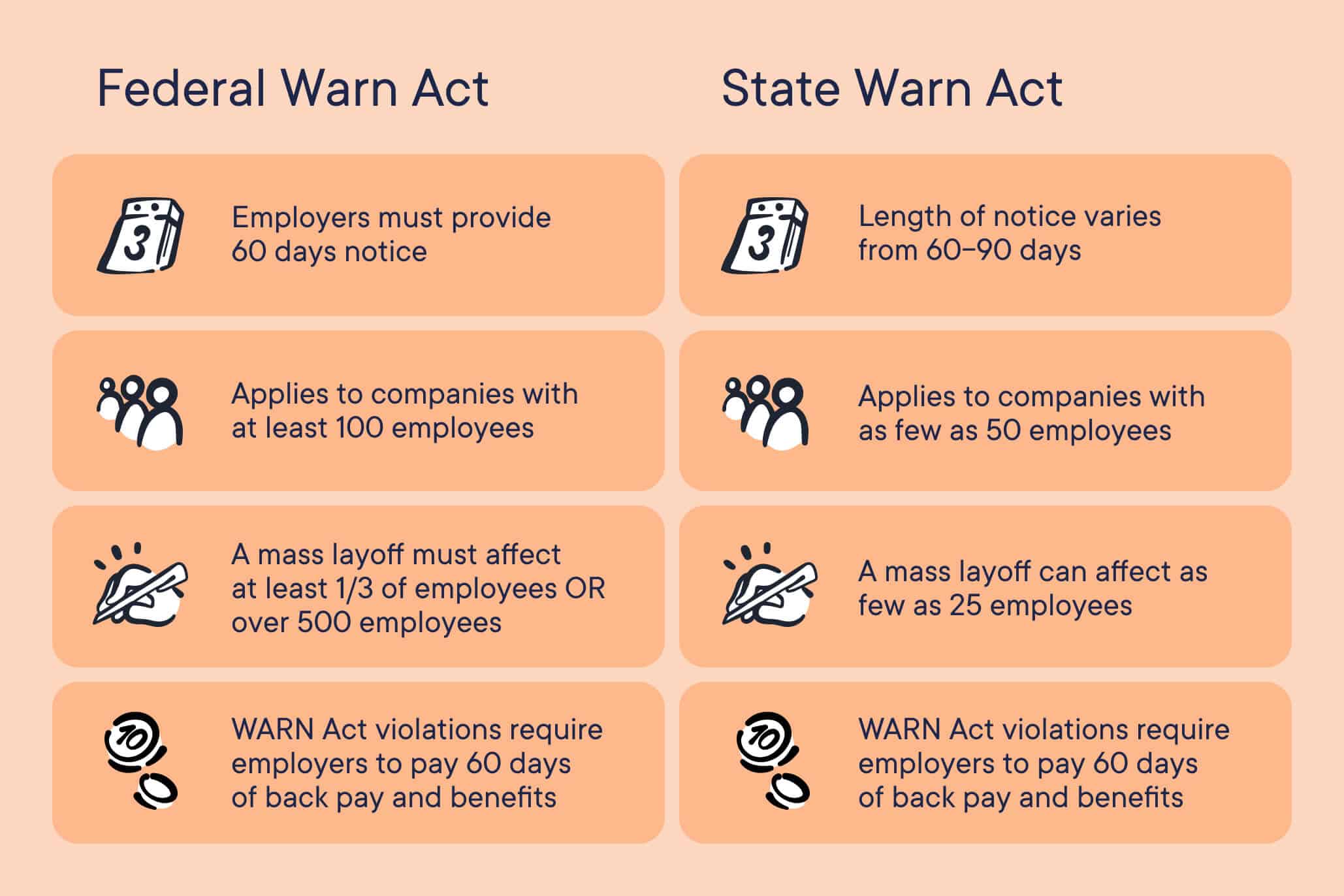
Preparing for a RIF?
Download our Essential Guide to Handling a Layoff
Request Pricing
Compare our rates to other providers
If you are planning to lay off employees in the state of New York, you will need to make sure that you comply with all regulations pertaining to the Worker Adjustment and Retraining Notification Act (commonly known as the WARN Act). This will ensure that your employees are treated fairly and that you are not penalized for your layoff or reduction in force (RIF) event.
To understand how to comply with the WARN Act in NY, we will have to look at three different areas:
- The federal WARN Act requirements
- The state-specific WARN Act requirements in NY
- How to comply with WARN Act NY laws
Before we dig into our analysis for each of these areas, make sure to download our simple WARN Act checklist with the link below:
What Are the Federal WARN Act Regulations?
The WARN Act has several regulations that shape who the law should be applied to at the federal level. This includes the following stipulations:
- The WARN Act applies to your organization if you have over 100 full-time employees.
- The WARN Act applies to all publicly and privately held companies.
- The WARN Act applies to all organizations that are for-profit or not-for-profit.
- A WARN notice must be given if there is a plant closing or a mass layoff.
The first three stipulations are relatively straightforward. The final stipulation, however, relies on the federal definition of a “plant closing” and “mass layoff,” which may vary from definitions set at the state level. We’ll get into that distinction for the state of New York in a minute.
To comply with the WARN Act on the federal level, you will need to send a WARN notice to your affected employees 60 days in advance of their last day with the organization. Then your organization must also notify the government about your reduction event. This notice must also be sent 60 days in advance to your state dislocated worker unit, as well as to the chief elected official of the local government in which your employment site is located.
Now let’s dive into the state-specific requirements for the WARN Act in NY, and how that compares to the federal regulations above.

Does New York Have WARN Act Regulations?
As explained above, there are federal regulations resulting from the WARN Act that all states must abide by. In addition to that, some states also have more stringent regulations specific to the companies located in their state (as well as for employees working in that state, such as remote workers).
New York is among those states which have tighter regulations that companies must follow.
As of June 2023, New York WARN Act regulations were updated with changes made by the state government due largely to the COVID-19 pandemic. This includes a way for businesses to apply for an exception if they cannot provide the state with the required 90 days of notice, but we’ll get to that in a minute.
What Is the NY WARN Act Statute?
In New York, businesses must adhere to the WARN Act if they have 50 or more full-time employees, which is a lower threshold than that imposed at the federal level. According to the NY Department of Labor (DOL), this covers:
- “Closings affecting 25 or more employees
- Mass layoffs involving 25 or more full-time employees (if the 25 or more employees make up at least 33 percent of all the employees at the site)
- Mass layoffs involving 250 or more full-time employees
- Certain other relocations and covered reductions in work hours”
These WARN Act NY requirements set a much lower bar than at the federal level. In comparison, the US DOL applies the WARN Act to any plant closing that “will result in an employment loss (as defined later) for 50 or more employees during any 30 day period,” as well as any mass layoff which “will result in an employment loss at the employment site during any 30 day period for 500 or more employees, or for 50-499 employees if they make up at least 33% of the employer’s active workforce.”
WARN Act NY Notice Requirements
While federal law requires organizations to submit notices to both federal and state-level agencies, NY takes it a step further. The New York DOL states here that:
“Covered businesses must provide all employees with notice 90 days prior to a:
- Plant closing
- Mass layoff
- Relocation
- Other covered reduction in work hours”
The New York DOL website goes on to stipulate that:
“Businesses must give notice to:
- All affected employees
- Any employee representative(s)
- The New York State Department of Labor (DOL)
- The Local Workforce Development Board (LWDB)
- The chief elected official of the unit or units of local government where the site of employment is located
- The school district or districts where the site of employment is located
- Each locality that provides police, firefighting, emergency medical or ambulance services, or other emergency services, to the locale where the site of employment is located”
Once again, this denotes a difference from the federal level, as the NY required notice time is much higher at 90 days compared to the federal government’s required 60 days.
WARN Act NY Allowed Exceptions
Like we briefly mentioned earlier, the WARN Act in NY now offers businesses the chance to file for an exception to the standard 90-day notice period. To do this, businesses need to provide additional information to state agencies who will review them and determine if an exception is warranted.
Here’s what the NY WARN Act legal document states:
“The State WARN Act allows certain exceptions under which the 90-day notice period may be reduced. The employer bears the burden of proof to show that the requirements for an exception have been met, i.e. when the employer asserts a defense in mitigation or exemption from the requirements of the Act or this part, the employer must provide documentation in support of the claimed exception.
In all circumstances set forth below, the employer must provide as much notice as possible in advance of the plant closing, mass layoff, relocation, or covered reduction in work hours to all required parties, and also include a statement of the reason for reducing the notice period and a factual explanation of the basis for claiming entitlement to such reduced notice period.”
This NY WARN Act law documentation goes on to outline what some of these exceptions may be, such as when a company is faltering but attempting to stabilize itself, when there are unforeseen business circumstances—such as a major client suddenly ending a contract—and when natural disasters impact the business.
WARN Act NY: Key Takeaways
While the WARN Act is simple enough to understand on a federal level, some states—including New York—have more rigorous laws to protect local workers from mass layoffs and plant closings. This guide covered many of the key differences, but always be sure to refer to the New York DOL website for the most comprehensive and up-to-date explanation of the law.
Understanding NY WARN Act requirements is vital if you do any business in the state of New York, especially since the law is constantly evolving year after year. If you are planning a mass layoff or reduction event in NY, please consult your legal team to ensure you are following all applicable local, state, and federal laws.
For information on the specific WARN Act requirements in other states that may apply to your organization, see our similar WARN Act state guides for New Jersey, Illinois, and California.
It can also be extremely helpful to offer outplacement services to employees who are affected by any such plant closing or mass layoff event. These services can help support their transition and provide a solution for any issues that may arise. Consult with your legal team and company stakeholders about what solutions might be right for your organization to help you navigate the complexities of your reduction event in the state of New York.
In need of outplacement assistance?
At Careerminds, we care about people first. That’s why we offer personalized talent management solutions for every level at lower costs, globally.


